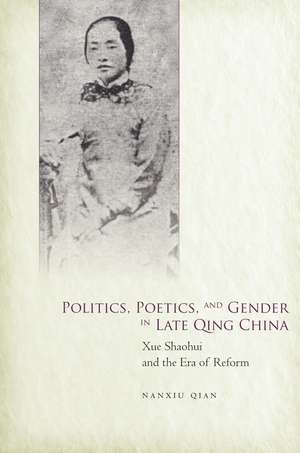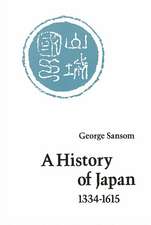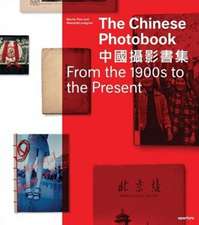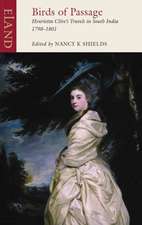Politics, Poetics, and Gender in Late Qing China – Xue Shaohui and the Era of Reform
Autor Nanxiu Qianen Limba Engleză Hardback – 5 mai 2015
In 1898, Qing dynasty emperor Guangxu ordered a series of reforms to correct the political, economic, cultural, and educational weaknesses exposed by China's defeat by Japan in the First Sino-Japanese War. The "Hundred Day's Reform" has received a great deal of attention from historians who have focused on the well-known male historical actors, but until now the Qing women reformers have received almost no consideration. In this book, historian Nanxiu Qian reveals the contributions of the active, optimistic, and self-sufficient women reformers of the late Qing Dynasty.
Qian examines the late Qing reforms from the perspective of Xue Shaohui, a leading woman writer who openly argued against male reformers' approach that subordinated women's issues to larger national concerns, instead prioritizing women's self-improvement over national empowerment. Drawing upon intellectual and spiritual resources from the freewheeling, xianyuan (worthy ladies) model of the Wei-Jin period of Chinese history (220–420) and the culture of women writers of late imperial China, and open to Western ideas and knowledge, Xue and the reform-minded members of her social and intellectual networks went beyond the inherited Confucian pattern in their quest for an ideal womanhood and an ideal social order. Demanding equal political and educational rights with men, women reformers challenged leading male reformers' purpose of achieving national "wealth and power," intending instead to unite women of all nations in an effort to create a just and harmonious new world.
Qian examines the late Qing reforms from the perspective of Xue Shaohui, a leading woman writer who openly argued against male reformers' approach that subordinated women's issues to larger national concerns, instead prioritizing women's self-improvement over national empowerment. Drawing upon intellectual and spiritual resources from the freewheeling, xianyuan (worthy ladies) model of the Wei-Jin period of Chinese history (220–420) and the culture of women writers of late imperial China, and open to Western ideas and knowledge, Xue and the reform-minded members of her social and intellectual networks went beyond the inherited Confucian pattern in their quest for an ideal womanhood and an ideal social order. Demanding equal political and educational rights with men, women reformers challenged leading male reformers' purpose of achieving national "wealth and power," intending instead to unite women of all nations in an effort to create a just and harmonious new world.
Preț: 450.29 lei
Preț vechi: 555.91 lei
-19% Nou
Puncte Express: 675
Preț estimativ în valută:
86.19€ • 92.67$ • 71.85£
86.19€ • 92.67$ • 71.85£
Carte tipărită la comandă
Livrare economică 19 decembrie 24 - 02 ianuarie 25
Preluare comenzi: 021 569.72.76
Specificații
ISBN-13: 9780804792400
ISBN-10: 0804792402
Pagini: 392
Dimensiuni: 160 x 235 x 30 mm
Greutate: 0.5 kg
Editura: MK – Stanford University Press
ISBN-10: 0804792402
Pagini: 392
Dimensiuni: 160 x 235 x 30 mm
Greutate: 0.5 kg
Editura: MK – Stanford University Press
Recenzii
"Poetry and prose sensitively read, carefully annotated, and deftly translated provide a subjective perspective on such topics as the limitations of a masculine approach to cultural reform, China's accommodation of Western ideas and technologies, and the political imperatives of the era. This book is a must read for scholars in Chinese women's history, modern Chinese history, and Chinese literary history."—Joan Judge, York University
"Although Xue Shaohui is not yet a household name, I suspect that she would become one with the publication of this book. Opinionated, learned, and indefatigable, the visionary pioneer in women's education and journalism should be celebrated as a role model today, yet she is virtually unknown in and out of China. In restoring Xue to her rightful place in history and in explaining the reasons for her obsolescence, Nanxiu Qian has proved herself to be as erudite, tough-minded, and poetic as the heroine of her book."—Dorothy Ko, Columbia University
Notă biografică
Nanxiu Qian is Associate Professor of Chinese Literature at Rice University.
Cuprins
Contents and Abstracts
Introduction
chapter abstract
The introduction presents the themes and ideas to be developed in the book. It first reviews the strengths and weaknesses of the previous studies on the late Qing reforms, against which it briefs the significance and the approaches of the book (as stated in the book abstract). It then introduces Xue's intellectual networks, which comprised of the members from her local Min (Fujian) writing-women circles and their supportive male associates, such as Xue's husband Chen Shoupeng (1857¿c. 1928) and Shoupeng's brother Chen Jitong (1852¿1907), as well as other Min male scholars who were related to the Fuzhou Navy Yard culture. Sustaining these women's subjectivity was the xianyuan spirit, a legacy from the Wei-Jin era. Literature, as the core constituent of the xianyuan and the Min writing-women traditions, naturally became the major means for women to advance their reform goals.1Xue Shaohui and the Min Writing-Women Culture
chapter abstract
This chapter explores the Min writing-women culture from Xue's perspective, based on Xue's reading of the literature and art of Min women, along with some major critical works on their poetic accomplishments. According to Xue, Min writing-women had been producing a culture of their own since the mid-seventeenth century. This culture boasted the Guanglu poetic school as its institutional manifestation and the xianyuan ideal as its intellectual foundation. Over time, the Min writing-women tradition had been disseminated horizontally through marital and communal ties and vertically through the mechanism of mothers' teaching. This culture made major contributions to the formation of Min poetics, and Min women poets surpassed their male counterpart in poetic accomplishments. This culture demonstrated its tenacity in the midst of the late Qing turmoil and prepared Min writing women for their future participation in the late Qing reforms.2The Chen Brothers and the Fuzhou Navy Yard Culture
chapter abstract
This chapter first examines the structure of the Fuzhou Navy Yard and its affiliated Academy that combined Chinese with Western educations, including English- and French-language instruction in science, engineering, and naval warfare. It then showcases the transformation of late Qing scholars by following the Chen brothers' personal journey from the Fuzhou Naval Academy to their scholarly and diplomatic careers in Europe. From the perspectives of the Chen brothers, in particular Chen Jitong because of his remarkable role in late Qing diplomatic, political, and cultural life, this chapter looks into the constituents of the Fuzhou Navy Yard culture, focusing on those that would have crucial influence on its future "marriage" to the Min writing-women culture. This culture features literature as its basis, women as its indispensable exponents, the press as its mechanism for spreading cultural values, and democracy as its core value.3A Marriage between the Two Cultures
chapter abstract
This chapter explores the mutual transformation of the Min writing-women and Fuzhou Navy Yard cultures, focusing on the union of the Fuzhou girl prodigy Xue Shaohui and the Fuzhou Naval Academy graduate Chen Shoupeng. Shoupeng's experiences abroad introduced Xue to a much broader spectrum of knowledge than what she had acquired from her Min writing-women upbringing, but repeated foreign invasions at Xue's doorstep soon tarnished the alluring luster of Western cultures. Chen Jitong's private life also reveals the complexity of this bicultural "marriage." Such mixed exposure to the outside world led Xue and some of her fellow Min writing women to a lifelong journey of negotiating between the cultural values of China and the West, enabling them to cultivate their unique visions in their future reform career.4The 1897-98 Shanghai Campaign for Women's Education
chapter abstract
One of the major themes of the 1898 reforms was women's education, yet for leading male reformers women's issues tended to be subordinated to larger nationalistic concerns. They expected women to abandon their age-long intellectual adherence to the writing-women tradition and turn to more pragmatic professional training, so as to change "useless" women into laborers to empower the nation. In contrast, women reformers gave priority to self-improvement over national empowerment, as exemplified in the 1898 Shanghai campaign for women's education. The campaign established the first women's association in China (Nü xuehui), published the first Chinese women's journal (Nü xuebao), and opened the first Chinese school for young elite women (Nü xuetang), all run by women. Via this triad, women instigated debates on reform with men and among themselves to promote their own agenda, agency, organizations, and specific strategies for achieving self-cultivation and national strengthening.5Translating the Female West to Expand Chinese Women's Space
chapter abstract
After the bloody termination of the Hundred Days in 1898, Xue and Shoupeng continued advancing the 1898 goals through translating Western literature, histories, and science. Their most important project was the compilation of the Biographies of Foreign Women (Waiguo lienü zhuan), the first systematic introduction of foreign women to the Chinese readership. This chapter argues that the Foreign Women resulted from women reformers' desire to break the longstanding demarcation between the "inner" and "outer" domains and to reposition the ideal "woman" in an ideal space, at home and in society, within the intersecting frameworks of the family, the state, and the world. In the process, foreign women's lives served not only as a model for Chinese women but also as a collective site where different visions of ideal womanhood were contested.6Introducing Modern Science and Technology through Literature
chapter abstract
As part of her reform efforts in the aftermath of the Hundred Days, Xue wrote broadly on modern science and technology when the topic had not yet attracted attention in the literature in China. Xue employed two literary forms to share her knowledge with Chinese readers¿classical parallel prose and the more accessible genre of quasi-vernacular fiction. This chapter looks first at her parallel prose essays that poeticized modern science and technology. It then examines her co-translation with Shoupeng of Jules Verne's Around the World in Eighty Days, which marked the first Chinese rendition of Western science fiction and the first of Jules Verne's works. The couple's extensive annotation to the text indicates that they aimed at translating this work into a textbook of world culture, history, and modern science and technology. Xue's intentional rewriting of some parts further added feminist touch to this work.7Xue's Self-Repositioning in the Family
chapter abstract
Amid changing relationships of gender and between family and state during the late Qing reforms, how would Xue reconsider a woman's position in the family? How did her ideas differ from women's self-positioning in late imperial China? Xue made clear in action and in theorization that, in accord with the current world situation, women had to break their cloistered position and walk into the public space. Drawing upon a broad, eclectic pool of intellectual resources, Xue reinterpreted conventional socio-political principles encoded in the core Confucian documents, and revised and gendered the male-dominated polity into a cooperative enterprise of men and women. Using Xue's personal life as an example, this chapter examines how Xue recast women's conventional roles¿wife, mother, daughter, and sister¿to fit her ideal womanhood to the changing socio-political situation.8Xue's Literary Response to the Late Qing Reforms
chapter abstract
This chapter probes Xue's poetic response to late Qing reforms. Her four hundred fifty traditional-style poems literally chronicled the era. The termination of the Hundred Days and the repressive aftermath only urged Xue into more profound contemplation on the purpose and practice of the reform. One major issue was women's proper positions within the guo amidst its re-conceptualization as state, country, and/or nation-state in the reform era. Xue would apply related ideas to her portrayal of women in the 1900 Boxer Rebellion. The final section examines Xue's last poems composed during the New Policy campaign and the constitutional movement, when Xue argued for a democratic republic as an ideal political structure for China.Conclusion
chapter abstract
Despite their significant contributions to the late Qing reforms, Xue and her cohorts were all but forgotten by the end of the dynasty, largely because they opted for a richly nuanced culturalism rather than a strategically oriented nationalism and were therefore written off by the "modernizing" Chinese patriarchy. Yet the power of nationalism and the growth of radical politics in twentieth-century China had not been able to efface late Qing women reformers. Recent studies have come to appreciate the multifaceted historical role of Chinese writing women. This case study of Xue and other writing women in the reform era is intended to provoke further explorations into the dynamism and variety of late Qing intellectual and social life. It also serves as a reminder of the value of the Chinese tradition, which is and has always been multidimensional, resilient, tolerant, and capable of incorporating other traditions into its vast repertoire.Descriere
This book examines the late Qing reforms from the perspective of the woman writer Xue Shaohui and her reform-minded colleagues, and thus offers a different and more comprehensive and nuanced understanding of the reform era than any previous work, showing in particular that late Qing women reformers were not merely passive objects of male concern, but rather active, optimistic, autonomous, and self-sufficient agents of their own reform ideals.











